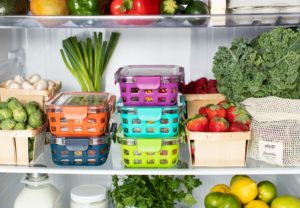Storage
Storage
Temperature, humidity and light can have a big impact on food. Storing food correctly will help it last as long as possible.
It will also help to maintain its nutritional value and ensure it is safe to eat.
Storing food the smart way.
Different foods need different environments to stay as fresh as possible for as long as possible. Our A – Z Food Guide breaks down the best storage solutions for each type of food but to highlight a few of the most commonly wasted items, did you know…
- Potatoes should be stored in a cool, dark place away from onions.
- Salad Leaves last better out of their plastic bags in a solid container with a damp piece of kitchen roll to stop the leaves getting squished and to slow wilting.
- Fresh Bread keeps best at room temperature in either a breadbin or a paper bag (rather than plastic). Don’t store bread in the fridge.
Top Tip: If you regularly waste a lot of bread, consider freezing slices of bread in twos or threes (well wrapped or in a freezer bag) and then defrost as you need.
Know your dates.
Remember: The ‘use-by’ date is a safety deadline – you can eat or freeze food up until this date, after that it could make you unwell.
The ‘best before’ date is a guideline to indicate food quality so food is still safe to eat after this date.
- Check food regularly – make a habit of checking use-by dates on perishable food in your fridge and eating or freezing it before the use-by deadline is up. Scan fruit and veg regularly for anything that’s starting to spoil and remove it as any gases from rotten produce can hasten the decline of other items.
- Create a ‘use next’ spot – if you have fresh produce approaching its ‘use-by’ date, store it all in one place in the fridge (ideally at eye level so you can’t miss it) to remind you to use it first!
Top Tip: The main reason we throw out food is not eating or freezing food before its use-by date passes – find out more on how to know your dates.
Make your fridge and freezer work for you.
- Know your fridge zones – different sections of your fridge will be best suited to different types of food. Find out what should go where.
- You can freeze more than think – check out our A-Z Food Guide for how best to freeze everything from raw onions to leftover herbs, homemade sauces and stocks to fresh milk and cream. Read more on freezing food safely.
- Don’t lose track – when life gets busy it’s easy to forget all the good intentions you had when you saved leftovers for the next day or popped something in the freezer to keep for another time. Where possible use clear Tupperware and freezer bags which can be labeled and dated, or keep a note in your phone (or on a kitchen noticeboard).
Top Tip: Our A-Z Food Guide also has advice on how long foods can safely be frozen.
Preserving Food
We preserve foods by drying, canning or freezing to save money and conserve resources to be eaten at another time. Preserving food extends its lifespan by either killing or slowing down the activity of bacteria which need oxygen and moisture to grow.
While some preserving methods can take time and specific tools, freezing fresh produce is an easy way to make it last as long as possible, e.g. freezing fresh herbs in an ice cube tray of olive oil to drop into a pan when cooking, or adding berries or chopped bananas to a freezer bag for smoothies.


